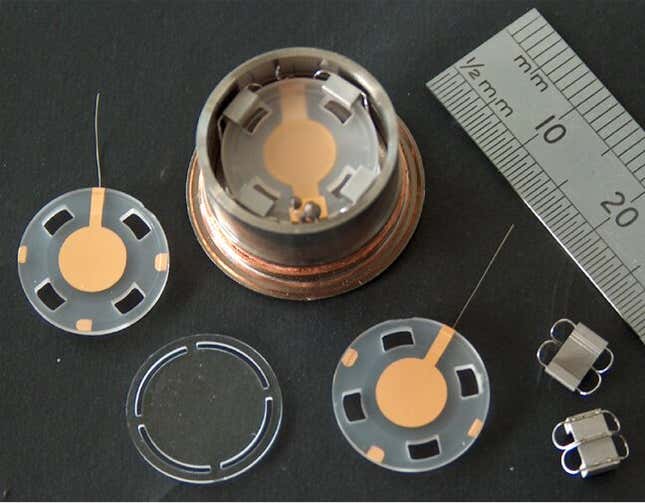
The disc-shaped resonator measures less than 2 centimeters across, yet the innocuous device is eavesdropping on spacetime. It’s a newly built acoustic wave resonator, and in its first 153 days of operation it detected a couple of events that researchers believe could be high-frequency gravitational waves, which have never been recorded before.
Gravitational waves were first detected in 2015 by the Laser Interferometer Gravitational-Wave Observatory; the waves are ripples in spacetime that are produced by the movement (or collisions) of massive objects, like black holes and neutron stars. But the waves so far detected are low-frequency signals, and, while it’s not yet proven, some astrophysicists believe that gravitational waves may also exist at higher frequencies, emitted by theoretical objects such as primordial black holes or clouds of dark matter. And if such waves do exist, they want to find them.
To that end, a team of researchers at the ARC Center of Excellence for Dark Matter Particle Physics and the University of Western Australia built this small resonator. The device is composed of quartz disc conducting plates and an amplifier, placed inside multiple radiation shields and cooled to protect from noise.
The disc vibrates when high-frequency acoustic waves pass through it, and those waves induce an electric charge in the quartz that’s picked up by the conducting plates. The amplifier makes the low-voltage signal easier for researchers to see. The resonator detected, well, something on May 12, 2019 and November 27, 2019, and the team’s results were published this month in the Physical Review Letters.

“It’s exciting that this event has shown that the new detector is sensitive and giving us results, but now we have to determine exactly what those results mean,” said William Campbell, a physicist at the University of Western Australia and a co-author of the paper, in a university press release.
There are a number of different things the high-frequency signal could be; a huge part of such work is tamping down hope and ensuring that you’ve eliminated all alternative possibilities. (Sherlock Holmes said something along these lines, too.) Besides gravitational waves, other explanations for the signal could be interference from other particles making their way through the detector, a nearby meteor, the detector itself having a technical problem, or, perhaps most tantalizingly—high-mass dark matter candidates.
A larger problem, though, is that high-frequency gravitational waves may not exist. Currently, they’re just an idea. It’s kind of like an ecologist looking for footprints of a thylacine—you’re searching for signs of something you’re not even sure is out there.
“The question if high-frequency gravity waves exist should be investigated, because if discovered it implies new physics,” Michael Tobar, a physicist at the University of Western Australia and a co-author of the paper, said in an email to Gizmodo. “Like when high-energy photons were discovered coming from the cosmos, it will lead to a new area of astronomy.”
In the experiment’s next phase, the team will build a duplicate detector as well as a muon detector; the second detector will expand the device’s frequency range and will allow the researchers to cross-correlate their findings, Tobar said. If the next generation of devices picks up a signal, then things could get pretty interesting.
More: If We Live in a Sea of Dark Matter, This Tiny Mirror Might Be Able to Detect It